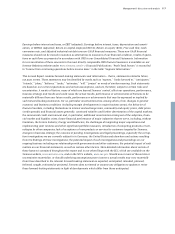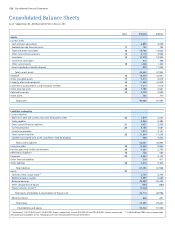Siemens 2008 Annual Report Download - page 210
Download and view the complete annual report
Please find page 210 of the 2008 Siemens annual report below. You can navigate through the pages in the report by either clicking on the pages listed below, or by using the keyword search tool below to find specific information within the annual report.-
 1
1 -
 2
2 -
 3
3 -
 4
4 -
 5
5 -
 6
6 -
 7
7 -
 8
8 -
 9
9 -
 10
10 -
 11
11 -
 12
12 -
 13
13 -
 14
14 -
 15
15 -
 16
16 -
 17
17 -
 18
18 -
 19
19 -
 20
20 -
 21
21 -
 22
22 -
 23
23 -
 24
24 -
 25
25 -
 26
26 -
 27
27 -
 28
28 -
 29
29 -
 30
30 -
 31
31 -
 32
32 -
 33
33 -
 34
34 -
 35
35 -
 36
36 -
 37
37 -
 38
38 -
 39
39 -
 40
40 -
 41
41 -
 42
42 -
 43
43 -
 44
44 -
 45
45 -
 46
46 -
 47
47 -
 48
48 -
 49
49 -
 50
50 -
 51
51 -
 52
52 -
 53
53 -
 54
54 -
 55
55 -
 56
56 -
 57
57 -
 58
58 -
 59
59 -
 60
60 -
 61
61 -
 62
62 -
 63
63 -
 64
64 -
 65
65 -
 66
66 -
 67
67 -
 68
68 -
 69
69 -
 70
70 -
 71
71 -
 72
72 -
 73
73 -
 74
74 -
 75
75 -
 76
76 -
 77
77 -
 78
78 -
 79
79 -
 80
80 -
 81
81 -
 82
82 -
 83
83 -
 84
84 -
 85
85 -
 86
86 -
 87
87 -
 88
88 -
 89
89 -
 90
90 -
 91
91 -
 92
92 -
 93
93 -
 94
94 -
 95
95 -
 96
96 -
 97
97 -
 98
98 -
 99
99 -
 100
100 -
 101
101 -
 102
102 -
 103
103 -
 104
104 -
 105
105 -
 106
106 -
 107
107 -
 108
108 -
 109
109 -
 110
110 -
 111
111 -
 112
112 -
 113
113 -
 114
114 -
 115
115 -
 116
116 -
 117
117 -
 118
118 -
 119
119 -
 120
120 -
 121
121 -
 122
122 -
 123
123 -
 124
124 -
 125
125 -
 126
126 -
 127
127 -
 128
128 -
 129
129 -
 130
130 -
 131
131 -
 132
132 -
 133
133 -
 134
134 -
 135
135 -
 136
136 -
 137
137 -
 138
138 -
 139
139 -
 140
140 -
 141
141 -
 142
142 -
 143
143 -
 144
144 -
 145
145 -
 146
146 -
 147
147 -
 148
148 -
 149
149 -
 150
150 -
 151
151 -
 152
152 -
 153
153 -
 154
154 -
 155
155 -
 156
156 -
 157
157 -
 158
158 -
 159
159 -
 160
160 -
 161
161 -
 162
162 -
 163
163 -
 164
164 -
 165
165 -
 166
166 -
 167
167 -
 168
168 -
 169
169 -
 170
170 -
 171
171 -
 172
172 -
 173
173 -
 174
174 -
 175
175 -
 176
176 -
 177
177 -
 178
178 -
 179
179 -
 180
180 -
 181
181 -
 182
182 -
 183
183 -
 184
184 -
 185
185 -
 186
186 -
 187
187 -
 188
188 -
 189
189 -
 190
190 -
 191
191 -
 192
192 -
 193
193 -
 194
194 -
 195
195 -
 196
196 -
 197
197 -
 198
198 -
 199
199 -
 200
200 -
 201
201 -
 202
202 -
 203
203 -
 204
204 -
 205
205 -
 206
206 -
 207
207 -
 208
208 -
 209
209 -
 210
210 -
 211
211 -
 212
212 -
 213
213 -
 214
214 -
 215
215 -
 216
216 -
 217
217 -
 218
218 -
 219
219 -
 220
220 -
 221
221 -
 222
222 -
 223
223 -
 224
224 -
 225
225 -
 226
226 -
 227
227 -
 228
228 -
 229
229 -
 230
230 -
 231
231 -
 232
232 -
 233
233 -
 234
234 -
 235
235 -
 236
236 -
 237
237 -
 238
238 -
 239
239 -
 240
240 -
 241
241 -
 242
242 -
 243
243 -
 244
244 -
 245
245 -
 246
246 -
 247
247 -
 248
248 -
 249
249 -
 250
250 -
 251
251 -
 252
252 -
 253
253 -
 254
254 -
 255
255 -
 256
256 -
 257
257 -
 258
258 -
 259
259 -
 260
260 -
 261
261 -
 262
262 -
 263
263 -
 264
264 -
 265
265 -
 266
266 -
 267
267 -
 268
268 -
 269
269 -
 270
270 -
 271
271 -
 272
272 -
 273
273 -
 274
274 -
 275
275 -
 276
276 -
 277
277 -
 278
278 -
 279
279 -
 280
280 -
 281
281 -
 282
282 -
 283
283 -
 284
284 -
 285
285 -
 286
286 -
 287
287 -
 288
288 -
 289
289 -
 290
290 -
 291
291 -
 292
292 -
 293
293 -
 294
294 -
 295
295 -
 296
296 -
 297
297 -
 298
298 -
 299
299 -
 300
300 -
 301
301 -
 302
302 -
 303
303 -
 304
304 -
 305
305 -
 306
306 -
 307
307 -
 308
308 -
 309
309 -
 310
310 -
 311
311 -
 312
312 -
 313
313 -
 314
314 -
 315
315 -
 316
316 -
 317
317 -
 318
318 -
 319
319 -
 320
320 -
 321
321 -
 322
322 -
 323
323 -
 324
324 -
 325
325 -
 326
326 -
 327
327 -
 328
328 -
 329
329 -
 330
330
 |
 |
114 Management’s discussion and analysis
Growth and financial performance
Our most important growth and nancial performance targets are summarized in the following paragraphs.
For more information on how we dene our nancial measures and how they relate to each other, see “Financial
performance measures.”
Growth. In scal 2009 we intend to increase our revenue by at least twice the rate of actual global GDP growth
in scal 2009. We believe we are well positioned to reach this target, in part due to new orders of approximately
€93.5 billion and a book-to-bill ratio of 1.21 in scal 2008. As noted above, most of our business is less exposed
to short-term economic cycles. In addition, we are investing in new solutions and supply-chain capabilities to
address opportunities in lower-end market segments, particularly in Asia.
Total Sectors prot. We aim to achieve Total Sectors prot between €8.0 and €8.5 billion in scal 2009, exclud-
ing impacts from restructuring and legal and regulatory matters. While we expect adverse macroeconomic con-
ditions to intensify market challenges for some of our businesses, we believe that the substantial organizational
changes we made in scal 2008 will enable our Sectors and regional organizations to compete effectively and
protably in the years ahead.
Income and EPS. We expect growth in income from continuing operations in scal 2009 to exceed growth in
Total Sectors prot. This excludes impacts from restructuring and legal and regulatory matters in scal 2009.
We anticipate that growth in net income in scal 2009 will be driven primarily by growth in income from con-
tinuing operations. At the same time, we expect to signicantly reduce the inuence on net income from discon-
tinued operations, having divested Siemens VDO Automotive (SV) and Siemens Enterprise Communications
(SEN) in scal 2008.
Cash generation and cash conversion. We expect free cash ow from continuing operations in scal 2009 to
include substantial cash outows stemming from €1.1 billion in severance charges and the provision of €1 bil-
lion associated with ongoing settlement negotiations regarding legal and regulatory matters, which were both
expensed in scal 2008 and mentioned above. As a result, we expect that in scal 2009, our cash conversion rate,
dened as the ratio of free cash ow to income, will come in below our mid-term target dened as 1 minus our
annual percentage growth in revenue.
We intend to maintain management attention on two key determinants of free cash ow in scal 2009: net work-
ing capital within operating activities, and capital expenditures. For scal 2009 we implemented a rigorous
approval process for capital expenditures, reaching up to the Managing Board level and taking into consider-
ation conditions in the macroeconomic environment. Our mid-term target range for additions to PPE and intan-
gible assets as a percentage of depreciation and amortization is 95%-115%. For more information regarding
expected future cash outows, see “Capital resources and requirements.”
Capital structure and ROCE. We calculate the target for our capital structure as adjusted industrial net debt
divided by earnings before interest expense, income taxes, depreciation, amortization and impairments
(EBITDA), also as adjusted. As a step toward optimizing this capital structure ratio, we conducted approximately
€4 billion in repurchases of Siemens shares in scal 2008, reducing shareholder dilution by approximately
53 million shares. The full share buyback plan is for up to €10 billion in share repurchases through 2010.
Our measure for return on capital employed (ROCE) is calculated as income from continuing operations (before
interest) divided by average net capital employed in continuing operations. We expect to improve ROCE in scal
2009 compared to scal 2008 on higher income from continuing operations.
